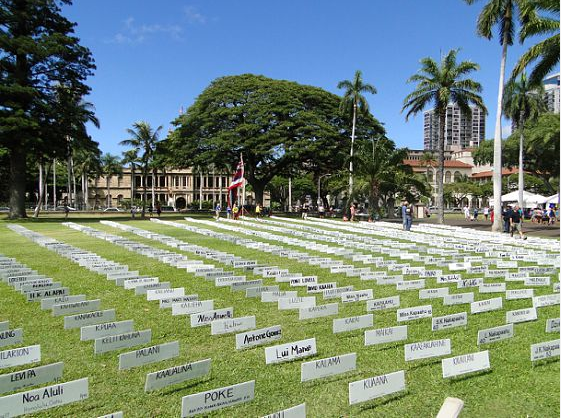Here’s some photos from the Queen’s Celebration at Iolani Palace yesterday and a news article from the Star-Advertiser.
Native Hawaiians, other Hawaii residents and visitors gathered to celebrate Queen Liliuokalani’s birthday yesterday with hula, mele and prayer on the grounds of Iolani Palace.
Among others, the girls of Halau La Onohi Mai Haehae, dressed in lavender and white, performed hula and sang songs commemorating the queen, a composer herself of poetry and music, including “Aloha Oe.”
But a number of attendees solemnly walked through roughly 1,500 names handwritten on white placards that lined the lawn of Iolani Palace yesterday, searching for ancestors who may have signed the 1897 petition against the annexation of Hawaii to the United States.
The 1,500 names represent just a few of the more than 21,000 who signed the petition against annexation of Hawaii in 1897. The petition was retrieved from the U.S. National Archives to Hawaii in 1997 by Noenoe Silva.
Check out GoPetition.com’s Famous Petitions in History, the first petition listed is the 1897 Petition Against the Annexation of Hawaii, and it has a pretty well-written and accurate summary of the history leading up to the petition and it’s significance.
The Hui Aloha Aina for Women and the Hui Aloha Aina for Men now organized a mass petition drive. They hoped that if the U.S. government realized that the majority of native Hawaiian citizens opposed annexation, the move to annex Hawaii would be stopped. Between September 11 and October 2, 1897, the two groups collected petition signatures at public meetings held on each of the five principal islands of Hawaii. The petition, clearly marked “Petition Against Annexation” and written in both the Hawaiian and English languages, was signed by 21,269 native Hawaiian people, or more than half the 39,000 native Hawaiians and mixed-blood persons reported by the Hawaiian Commission census for the same year.
Four delegates, James Kaulia, David Kalauokalani, John Richardson, and William Auld, arrived in Washington, DC on December 6 with the 556-page petition in hand. That day, as they met with Queen Lili’uokalani, who was already in Washington lobbying against annexation, the second session of the 55th Congress opened. The delegates and Lili’uokalani planned a strategy to present the petition to the Senate.
The delegation and Lili’oukalani met Senator George Hoar, chairman of the Senate Committee on Foreign Relations on the following day, and on December 9, with the delegates present, Senator Hoar read the text of the petition to the Senate. It was formally accepted. The next day the delegates met with Secretary of State John Sherman and submitted a formal statement protesting the annexation to him. In the following days, the delegates met with many senators, voicing opposition to the annexation. By the time the delegates left Washington on February 27, 1898, there were only 46 senators willing to vote for annexation. The treaty was defeated in the Senate.



Leave a Reply
You must be logged in to post a comment.